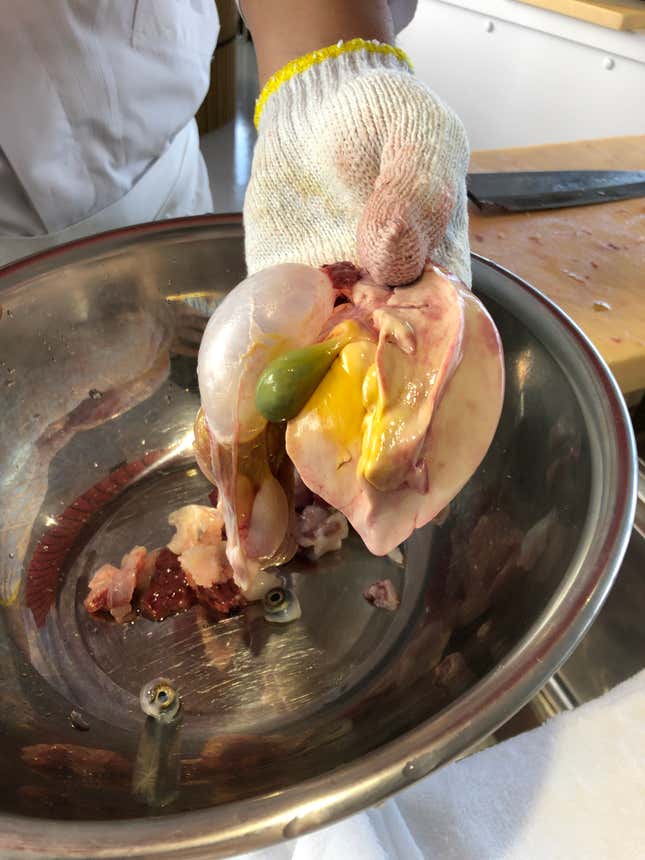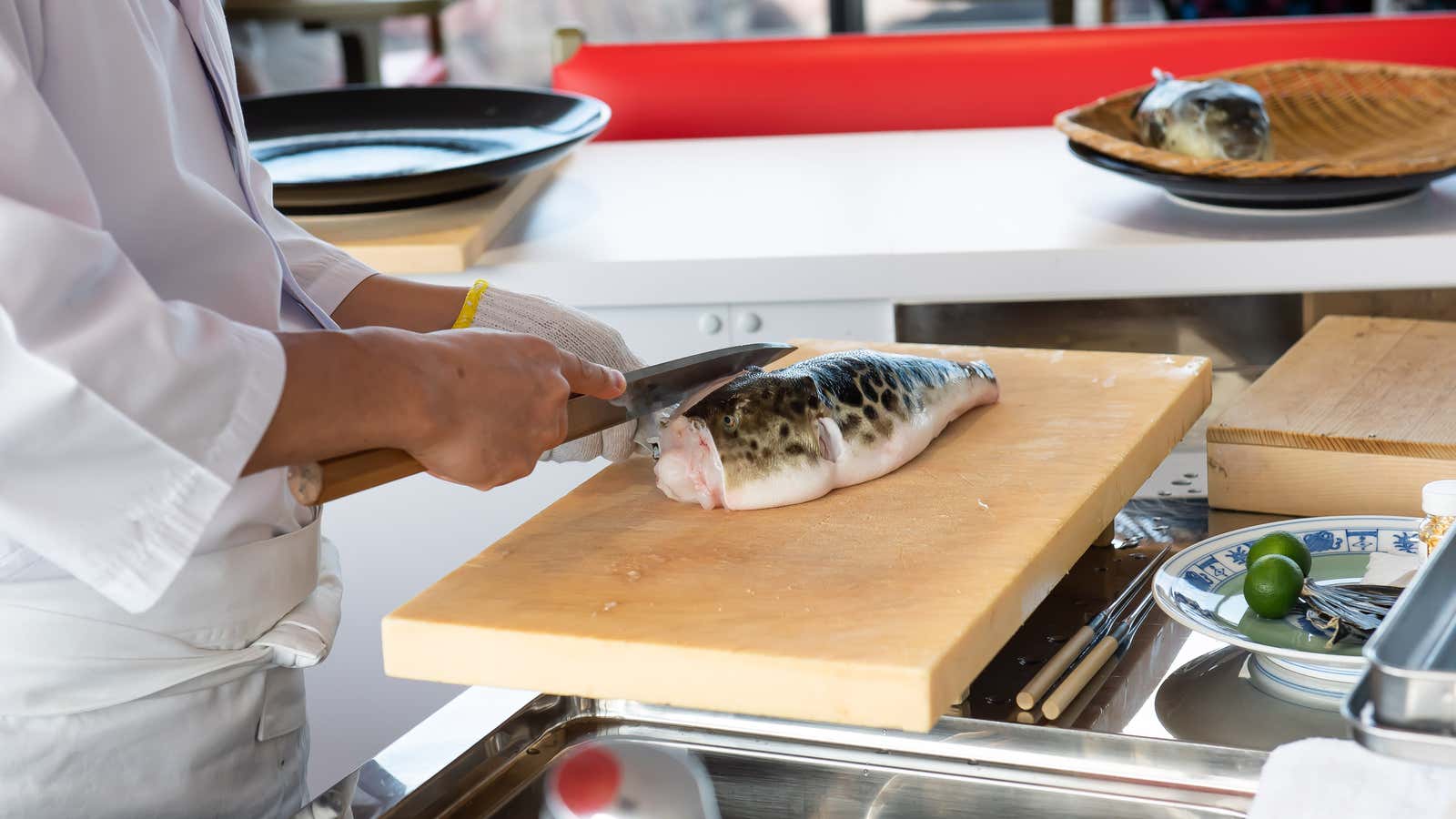The plump, mottled fugu sits on a well-worn wicker platter and stares up at us with bright and shiny yellow eyes. Fat and tapered like a monstrous tadpole, its belly is a pale, rose-tinted pink, and it has thick lips and high, wide-set nostrils. It’s hard to believe such a goofy looking fish carries enough poison in its body to kill multiple people.
If you’ve heard of the famously poisonous fugu it’s probably because of The Simpsons. When Homer is served what is believed to be an inexpertly butchered portion of fugu by an apprentice sushi chef (the master being preoccupied with Mrs. Krabappel in the back of a car), he’s rushed to the hospital and told that he has 24 hours to live.
According to chef Takeshi Suda, that’s not so far from the truth. Suda is a washoku (“Japanese Cuisine”) chef at Gyosho Dining Okimizuki, a seafood restaurant with ocean views that is, seemingly without irony, located inside of the Kamo Aquarium in Tsuruoka City.
While fugu aren’t exclusively from the seas outside Tsuruoka City, this is a particularly good place to try the specialty. Tsuruoka, which sits on the northwestern coast of Japan in the Yamagata prefecture (which itself is inside of the region of Tohoku), is a UNESCO-designated Creative City of Gastronomy. This means that the food culture of the city and surrounding area—and the unique regional ingredients they have access to—make it singular and unique in the world. In a country famous for its food, Tsuruoka City (and the wider Tohoku region) are standouts.
“As a chef you’re not allowed to even touch the puffer fish without a special license,” Suda explains. As he skillfully cuts into the fish and breaks it down we can see that the guts range in color from caucasian pink to French’s Mustard yellow to bile green, and he specifically points out the liver. “If you have even a millimeter worth of that particular organ, you will die.” The same goes for the kidneys.
Over the past decade or so the actual danger of fugu has become subject to debate. The Manbou Corporation, with the support of the Saga prefecture, claimed that the way it fed its farm-raised fugu made it develop without the potent neurotoxin that has made the fish so famous, and the company petitioned for the sale of fugu liver. Fish farms in China have also made the same claim. Absent the toxin, fugu liver is touted as a delicacy that surpasses foie gras.
In Japan fugu butchery still requires a license, though, and because of the skill required to prepare it and the high cost of the fish itself, it’s a luxury typically reserved for formal events or celebrations.
The fugu that Suda is preparing is a variety called torafugu (“tiger fugu”), named for the mottled pattern that appears on its skin. Torafugu is the highest grade of fugu available, and Suda says that at the peak of its fishing season it can sell for $200 per kilogram. That price can get even higher in metropolitan areas such as Tokyo, or if the chef and/or restaurant are particularly exclusive or well-regarded. While you can find fugu at a typical sushi restaurant for as little as $60, Suda says that’s because restaurants order their fugu pre-sliced. If you want it sliced fresh (and poison-free) by an artisan, you’re going to pay more.

Learning to butcher and serve fugu requires deliberate, specialized training, and when Suda was enrolled in culinary school, fugu preparation was its own special track. Chefs with that specific skill set are in high demand, and with it comes higher pay. “It’s almost like a completely different level of training,” Suda says. “You have a sushi chef, and then you have a specialist who can work with the fugu.”
As he speaks, Suda carefully uses long steel chopsticks to arrange the folds of translucent white flesh on a serving plate into a tableau of a crane flying above an ocean. The trimmings and more sinewy pieces become jumbled seaspray, and carved limes line the bottom of the scene, like boulders lining the edge of a storm-tossed beach. He carefully lays gold leaf over the tips of the crane’s wings, feathers catching the rays of the sun.
It’s a very prestigious position, Suda explains, his eyes on his work, but it can also be quite nerve-racking, and the training is arduous: “There are some people who just refuse to do it.” For the first two years the work is heavily supervised, and after that is an eight-year apprenticeship, during which chefs are allowed to prepare the fish, but can’t serve it directly to customers without supervision. Suda has been preparing fugu for 17 years, but he says it took him the full decade of training before he began to feel confident in his skills. Now his restaurant is considered the single best place to eat fugu in the entire Yamagata prefecture.
With his careful butchery concluded, Suda gently places the platter before us. The taste of the fugu is subtle, not exactly bland but also not overtly flavorful, and the fish has a fibrous texture that requires persistent chewing. This dish might be expensive, but it lacks the fatty extravagance of a piece of tuna belly or the creamy, tongue-coating intensity of sea urchin. Taken out of context, it’s probably not a fish your average American would gravitate toward. What’s interesting, though, is that, even when prepared by a master, the experience feels legitimately risky. Maybe that’s the point. After all, how many other dishes can offer both fear and luxury in equal measure?
